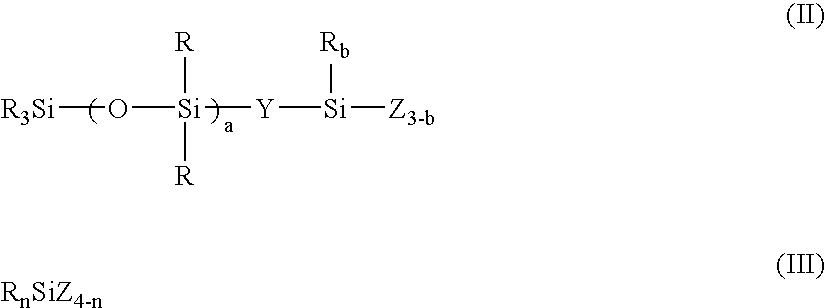Antifouling coating compositions and coated articles
a coating composition and coating technology, applied in the direction of biocides, lighting and heating apparatus, heating types, etc., can solve the problems of increasing processing costs, and high cost of silane compounds or cured products (coatings) thereof, so as to improve surface protection function and durability, improve water repellency and oil repellency, and improve the effect of surface protection
- Summary
- Abstract
- Description
- Claims
- Application Information
AI Technical Summary
Benefits of technology
Problems solved by technology
Method used
Image
Examples
preparation example 1
[0197] A 3-liter flask equipped with a stirrer, condenser and thermometer was charged with 175 g (0.20 mole) of an organosilicon compound of formula (i):
(CH3)3Si—(O—(CH3)2Si—)9—O—Si(OCH3)3 (i),
700 g of t-butanol, and 8 g of a solid acid catalyst, which were stirred and mixed at 25° C. To the flask, 36 g (2.0 moles) of deionized water was added dropwise over 10 minutes. The liquid was white turbid immediately after the addition. Moderate exothermic reaction took place and hydrolysis completed after 1 hour whereupon the liquid turned clear. To the liquid was added 832 g (4.0 moles) of tetraethoxysilane. The mixture was stirred at room temperature for one hour, after which 288 g (16.0 moles) of deionized water was added dropwise over 30 minutes. Moderate exothermic reaction took place so that the internal temperature reached 55° C. at the maximum. After the completion of dropwise addition, the liquid was stirred at room temperature for 24 hours. Then the solid acid catalyst was rem...
preparation example 2
[0200] A coating liquid #2 was prepared as in Preparation Example 1 aside from using instead of the compound (i), 488.4 g (0.20 mole) of an organosilicon compound of formula (ii).
(CH3)3Si—(O—(CH3)2Si—)30—CH2CH2—Si(OCH3)3 (ii)
[0201] The liquid was analyzed by GPC, finding a number average molecular weight of 12,900 and a single peak. The liquid was a solution of a resin wherein m=0.06, a=30, p=0, and q=0.80, when expressed in terms of the parameters in formula (I). Note that R═CH3, Y═CH2CH2, and X═OH, OCH3 and OC2H5. The active component was 15.0%.
preparation example 3
[0202] A coating liquid #3 was prepared as in Preparation Example 1 aside from using 67.6 g (0.20 mole) of an organosilicon compound of formula (iii):
(CH3)3Si—O— (CH3)2Si—CH2CH2—Si(OC2H5)3 (iii)
instead of the compound (i) and a mixture of 20.8 g (0.10 mole) of tetraethoxysilane and 13.6 g (0.1 mole) of methyltrimethoxysilane instead of 832 g (4.0 moles) of tetraethoxysilane.
[0203] The liquid was analyzed by GPC, finding a number average molecular weight of 3,450 and a single peak. The liquid was a solution of a resin wherein m=0.50, a=1, p=0.25, and q=0.76, when expressed in terms of the parameters in formula (I). Note that R═CH3, Y═CH2CH2, and X═OH, OCH3 and OC2H5. The active component was 7.1%.
PUM
| Property | Measurement | Unit |
|---|---|---|
| time | aaaaa | aaaaa |
| temperature | aaaaa | aaaaa |
| average primary particle size | aaaaa | aaaaa |
Abstract
Description
Claims
Application Information
 Login to View More
Login to View More - R&D
- Intellectual Property
- Life Sciences
- Materials
- Tech Scout
- Unparalleled Data Quality
- Higher Quality Content
- 60% Fewer Hallucinations
Browse by: Latest US Patents, China's latest patents, Technical Efficacy Thesaurus, Application Domain, Technology Topic, Popular Technical Reports.
© 2025 PatSnap. All rights reserved.Legal|Privacy policy|Modern Slavery Act Transparency Statement|Sitemap|About US| Contact US: help@patsnap.com



